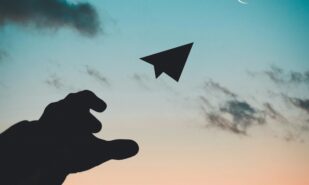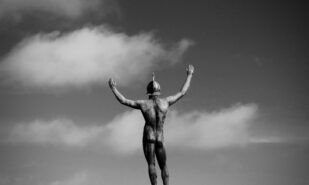The moment the aeroplane leaves the runway, I allow myself to drift away from the strip of rational control. The dorsolateral prefrontal cortex slips into stand-by, and the DMN — the Default Mode Network — lights up instead. That, at least, is what the neuroscientists call it. I simply call it autopilot.
Thought on autopilot
Alexander Pope, my English namesake, wrote of the “eternal sunshine of the spotless mind” three centuries ago. The phenomenon itself was only seriously examined in the late 1990s, when the neuroscientist Marcus Raichle and his colleagues at Washington University in St Louis discovered, through brain-scanner experiments, that even when we are doing nothing, the mind glows with activity. Archimedes’ bath, Mendeleev’s revelatory dream, Nietzsche’s solitary hikes through the Alps — each was an immersion in autopilot, a state that has gifted humanity some of its deepest insights.
Here lies the paradox: the brain switches on precisely when we switch off, gazing at billowing cumulus clouds through an aeroplane window and teasing meanings from their shapes — a rabbit scented with strawberries from a country house childhood, an alligator ready to swallow both rabbit and childhood whole. Let go of reality, start to imagine, and the eternal sunshine of the spotless mind kicks in.
It is waking sleep, when logic no longer holds us in check. The dorsolateral censor retreats and inspiration emerges — not as a descending muse but as a side effect of leaving the grey matter to its own devices. We allow ourselves so rarely to daydream or to stare aimlessly out of an aeroplane window that every small epiphany feels miraculous.
Down on the ground, hundreds of practices compete to silence the ceaseless chatter: meditation, yoga, tea and cacao ceremonies, womb-breathing (for those equipped with one). Amazonian shamans, by contrast, exalt the torrent of thought, gathering it into a single beam and flinging it towards the cosmos. Others simply sit by a fire, watching flames burn their thoughts to glowing embers.
Behind the DJ decks I love to watch a dancefloor detach from reality. Morning techno sessions are my favourite — group meditations set to a relentless beat. Once, at sunrise on a Goan beach, I was finishing a set when five bare-chested, tattooed men emerged from the mangroves. Bearded and silent, they advanced in single file, miming the strokes of oars like Vikings steering a miniature longship towards the sacred shores of Lindisfarne. They sliced through the waves of dancers until they reached the DJ booth, their entrance so startling that I forgot to cue the next track.
In sudden silence they raised their arms to the sky — and behind me the first spear of sunlight shot over the horizon. “SOL-FA-RID! SOL-FA-RID! SOL-FA-RID!” they chanted, their cry instantly taken up by hundreds on the sand. I didn’t simply cue in the next track, I fused it with the roar of a crowd delirious with sunrise. Music gave them revelation, and they repaid me with inspiration. I played on for another three hours, unable to stop.
Afterwards we shared beers. They turned out to be Icelanders, genuine descendants of Vikings, and told me the legend of Solfarid — the dream-ship sailing towards the sun, a myth of eternal yearning for light and the discovery of new worlds. No logic, only reverie. Pure DMN: the inner autopilot carrying its solitary Solfarid through the mists of consciousness towards its own spotless shining.
That morning on the beach, nearly twenty years ago, I did not think about the collective unconscious, yet I felt its force for the first time. The crowd, breathing in the Icelanders’ cry, fused into a single organism. The default network unfolded not within one brain but across hundreds. Jung wrote that deep within each psyche lie archetypes shared by all humanity. In such moments they surface, alive in songs, dances, shouts and prayers — around a fire, at a stadium concert, or circling the Kaaba.
Wherever shared energies arise, so too does the temptation to steer them. The collective unconscious not only unites; it is perilously easy to manipulate. Priests, politicians and marketers knew this long before Marcus Raichle: the ecstatic cries of Aztec sacrifices, the Arab Spring, the queues outside Apple stores on launch day — at root they are the same mechanism. The method is simple: tap into our autopilot and guide it where you will.
But autopilot sometimes malfunctions. Instead of soaring towards inspiration, it can circle endlessly around a single obsessive thought. Neuroscientists have observed that in depression the DMN becomes hyperactive, looping self-criticism and guilt, chewing pain without end. The same happens collectively: when a negative image captures the shared flow we see mass hysteria and fanaticism. A crowd is capable of miracles of unity — and of destruction.
This is how enemies are conjured, phantom threats invented, myths of national greatness manufactured. Propaganda — from any side — is the dirtiest exploitation of the default network, now scaled to an entire nation: a collective dream where inspiration is replaced with fuel for war.
What can resist this? I believe it is art. Yes, art has always served propaganda, but it contains within itself the antidote to ideology: the freedom of interpretation. It creates alternative narratives, stitching delicate counter-threads through mass hysteria, as Hendrix’s guitar did at Woodstock or graffiti on the Berlin Wall. And if we can learn to activate the DMN collectively not for panic or hatred but for a project of peace, each of us may find our own Solfar — a small ship of hope sailing together not under slogans and gaudy national flags, but beneath a shared, hard-won vision of the future.





